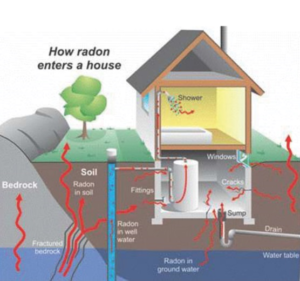Learn Your County Radon Levels To Stay Safe from Radon
 Radon is the second-leading cause of lung cancer in the United States, with up to 21,000 lung cancer deaths per year attributed to radon. Knowing the dangers of radon, homeowners should also know that some regions and households are more susceptible than others due to factors like local geology. To ensure that your home is safe from the dangers of radon, Radon-Rid, LLC provides a tool to help you check your county radon levels to keep you informed and aware of radon’s presence.
Radon is the second-leading cause of lung cancer in the United States, with up to 21,000 lung cancer deaths per year attributed to radon. Knowing the dangers of radon, homeowners should also know that some regions and households are more susceptible than others due to factors like local geology. To ensure that your home is safe from the dangers of radon, Radon-Rid, LLC provides a tool to help you check your county radon levels to keep you informed and aware of radon’s presence.
What Causes Different County Radon Levels?
While radon, as an element, is found all over the Earth, each region has different levels and quantities of radon. Radon is a radioactive gas formed by the natural decay of other elements: thorium and uranium. This decay occurs in soil, rocks, and water. Each region’s unique geology means that radon levels across the country, and even within states, are different. As an example, radon levels are typically higher in the northeastern and Midwest states than in southern states. Much variation exists, however, and two identical homes next to each other could have completely different radon gas levels. One could have elevated levels while the other has no discernible radon presence.
Knowing both your county radon levels and the radon levels of your home are vital to knowing if you need a professional to provide radon remediation to keep your family safe.
What Is A Safe/Unsafe Level of Radon?
Radon concentration in the air is measured in units of picoCuries per Liter (pCi/L). As for a safe level of radon: Radon is radioactive, and is best avoided whenever possible. However, the national average of outdoor radon levels is 0.4 pCi/L, with local levels varying. While organizations such as the Environmental Protection Agency (EPA) lack an officially designated safe level of radon, certain radon levels are used as guidelines.
For example, if a home has a radon level of 4 pCi/L or above, the EPA recommends the homeowners take immediate action to reduce radon in their home. Because radon is undetectable to human senses, getting your home tested is the only sure way to know the radon level of your home.
What You Can Do To Stay Safe from Radon
Although radon is found in water, the majority of people come into contact with radon in the air, and can have resulting lung ailments when exposed to radon in the air in their homes. Again, the best way to stay safe is to contact a professional and get your home tested and remediated if necessary. Learning your county radon levels will also give you the tools to raise awareness and encourage others in your area to test their homes.
Call Radon-Rid, LLC for Radon Testing and Radon Remediation in Pennsylvania
Radon-Rid, LLC’s team has years of experience with radon testing and remediation. We are committed to helping keep you and your family safe. Our certified specialists take the time to understand your concerns and answer your questions, from state and county radon levels to the best solutions for your home. For radon testing and remediation services that you can trust, contact us today.
Related Posts
Why Are More People Testing for Radon in 2020?
Why Should I Hire a Professional Radon Testing and Remediation Company?
Is Radon Testing Necessary When Buying A Home?
We Want to Help
"(required)" indicates required fields
Categories
- Blog (48)
- Environmental Pollution (2)
- Family Health (9)
- In the News (10)
- Lung Cancer (5)
- Radon Remediation (10)
- Radon Testing (24)
Radon – The Silent Killer
Radon In Your Home
- Learn More About Radon Levels in Your County
- Take a few minutes to browse our Get To Know Radon Online Presentation.
- When you are finished, be sure to tell a loved one about our testing programs offered in Berks, Chester, Delaware, Lancaster, Montgomery & Philadelphia Counties.